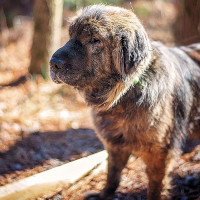Appearance of the Shar Tzu
|
| The Shar Tzu is a unique blend of two different and distinct parents. The Shar Pei has a wrinkled coat that gives the impression that the dog has chosen the wrong size coat, while the Shih Tzu has a long, flowing coat and characteristic long facial hair. Consequently, the appearance of puppies in a litter can vary according to the genes they inherit from the parent dog. In general, they are medium-sized, solidly built dogs with beautifully proportioned bodies. The head tends to be either thin and narrow, or blocky like the Shar Pei, but in either case it is rounded at the top with ears set well to the sides. Again, ears can vary from litter to litter or puppy to puppy, ranging from small and straight to long and floppy. The chest is generally quite deep, and the dog has strong but elegant legs and well-padded paws that enable him to go from a standing start to a run in seconds. Whether your dog inherits the wrinkled face of the Shar Pei or the lion's mane of the Shih Tzu is a matter of genetics. But whichever you choose, you're sure to get a very special dog who will be a loyal and devoted companion, with a natural look and sculpted appearance. |
Temperament of the Shar Tzu
|
| The Shar Tzu can be a little reserved with strangers, distant even, but never with you. They are known to be loyal and devoted companions, and have a happy outlook on life. Although not a small dog, they adapt well to life in an apartment, provided they take a daily walk to get out and socialize. They're not very active, preferring to lounge around and watch what you're doing, but aren't immune to a game or two if need be. If you have a home with a secure yard, they'll patrol the yard to make sure no unwanted furry creatures get in, and they'll warn strangers to think twice before loitering on your property. The Shar Tzu responds well to training because it's an intelligent dog, but it can get bored if training is the same day after day. Mix things up a bit, add a little fun, and your dog will have a greater attention span and learn faster. Toys that challenge your dog are fun, especially those he has to manipulate to get a treat. But keep in mind that most toys will probably be destroyed during play, but they'll be fun while they last. As a family dog, the Shar Tzu is a good choice, even if you have to supervise play with young children. This breed of dog doesn't like having its ears or tail pulled, so teach your children to treat the dog gently to avoid nipping or growling. They are quite protective of their family, very affectionate and loyal. They are fun to be around as they have a cheerful temperament and respond well to praise and petting. The Shar Tzu is a hard-to-find hybrid, but if you find one, it will become a valuable companion and friend. |
Needs and activities of the Shar Tzu
|
| The Shar Tzu dog will appreciate a daily walk around the neighborhood or to the dog park, where it can burn off energy and socialize with other dogs and people. Be sure to keep your dog on a leash to prevent him from chasing small furry animals that he might consider prey. The Shar Pei's hunting instinct will be strong. Exercise your Shar Pei during the cooler hours of the day, as it can suffer from heatstroke in hot weather. Your dog will appreciate a selection of toys to play with, and loves to play with older children. The Shar Tzu responds well to consistent training, a caring attitude and lots of praise. This attention to his ego will often overcome any slight stubbornness he may have. Keep training fun, with plenty of surprises, and your dog will stay focused and enjoy the training instead of switching off and sulking. This breed of dog is moderately active and enjoys a good walk, but it also appreciates a good cuddle and a nap on or next to you. |
Maintenance of the Shar Tzu
|
| The Shar Tzu has a dense coat that needs daily brushing to prevent tangling. It sheds very little, but still needs to be brushed to keep it looking its best. While brushing, check your dog for wounds and sores, and treat him if necessary. If your dog has the longer coat of the Shih Tzu, it may be easier to have it trimmed to reduce maintenance. These dogs often have skin wrinkles around the face or shoulders, so check for inflammation or sores inside the fold. When your dog gets wet, whether from playing or bathing, make sure the skin folds are dry to avoid any health problems. Ears and eyes are also prone to infection or health problems in this breed. Once again, check that your dog doesn't have red, watery eyes or infected, smelly ears. Using specialized dog products, such as shampoos, ear-cleaning lotions and others, will help your dog's skin retain its natural oils and prevent allergies. Your dog's teeth should also be cleaned regularly. When you get your puppy for the first time, you should teach him to do this, as it will make life easier for you when your dog gets bigger and stronger. Make grooming fun, praise him and reassure him. Your dog will appreciate this special time spent with you. |









 English (United Kingdom)
English (United Kingdom)